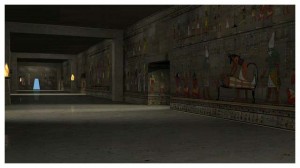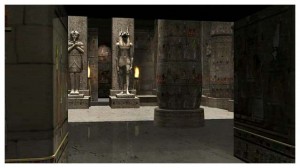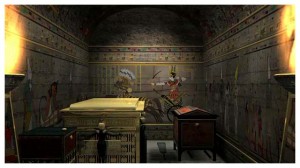Labyrinth of Egypt
Although there are very few remains, and historical accounts seem to differ, the Labyrinth of Egypt, the Labyrinth of Hawara, did actually exist over four thousand years ago. The Labyrinth of Egypt was located near the ancient town of Arsinoe (Crocodilopolis), and south of the pyramid of Hawara, in the area known today as the Fayum.
The actual location of the Egyptian Labyrinth was discovered by Professor Flinders Petrie in 1888. The Labyrinth itself had been so completely demolished that the only remains left was a large bed of stone fragments. In this pile of stone chips a few items of interest were discovered, including scattered bits of the foundations, solid granite shrines, a large well, north and south facing door jambs, fragments of statues and a large granite figure of Amenemhat III, who is widely credited with building the Labyrinth. There were enough fragments left from the original foundations to enable Petrie to determine the size and position of the structure.
 The original purpose of the Labyrinth is still a matter of conjecture. It is possible that the site was used as a meeting place for administrative and government purposes. However it is more likely that the site was intended to be a large impressive mausoleum. It is absolutely clear, based on the fragments from various statues of gods and goddesses found on the site, that it was a place where a variety of great deities were worshiped.
The original purpose of the Labyrinth is still a matter of conjecture. It is possible that the site was used as a meeting place for administrative and government purposes. However it is more likely that the site was intended to be a large impressive mausoleum. It is absolutely clear, based on the fragments from various statues of gods and goddesses found on the site, that it was a place where a variety of great deities were worshiped.
The Greek writer Herodotus visited the Labyrinth of Egypt, and provided a detailed account of his visit and impressions of the site. In his book Herodotus explained that the Egyptians had divided the land into twelve parts, and that each part of Egypt has its own king. These kings, Kerodotus, explained, decided to combine their efforts and create a memorial of themselves. They constructed the Labyrinth, near Lake Moeris and across from the city of crocodiles (Crocodilopolis). Herodutus decribes the Labyrinth as being "greater than words could tell... all of the works and buildings of the Greeks put together would certainly be inferior to this labyrinth as regards labour and expense." As impressive as the pyramids were, Herodotus found the Labyrinth to be far a greater accomplishment.
 The Labyrinth had twelve covered courts with doors on each opposite end. There were six courts on the North side, and six courts on the South side. Each of the courts connected with the others and were surrounded by a great wall. There were two different types of rooms. The first type was above ground, and the second type was below ground. There was fifteen hundred of each type of room. Visitors were not allowed into the lower chambers. These chambers were strictly guarded since they contained the tombs of the kings that created the Labyrinth, as well as the tombs of the sacred crocodiles.
The Labyrinth had twelve covered courts with doors on each opposite end. There were six courts on the North side, and six courts on the South side. Each of the courts connected with the others and were surrounded by a great wall. There were two different types of rooms. The first type was above ground, and the second type was below ground. There was fifteen hundred of each type of room. Visitors were not allowed into the lower chambers. These chambers were strictly guarded since they contained the tombs of the kings that created the Labyrinth, as well as the tombs of the sacred crocodiles.
The rooms that were above ground were described by Herotus as being super human in size. The system of passages though the courts, rooms and columns was very detailed and confusing. The roof that covered the entire structure was made of stone, and the walls inside the Labyrinth were covered with intricate carvings, inscriptions and paintings. Each of the courts were surrounded by by perfected joined white stone columns. The pyramid that stood outside the Labyrinth was 240 feet high, with massive figures on it and could be entered by an underground passage.
 The Labyrinth was also described four hundred years after Herodotus by Strabo. He also wrote about the Labyrinth after his visit. Strabo described the Labyrinth as "a work equal to the Pyramids." He described the Labyrinth as a massive palace that included many palaces within itself. There was a number of courts that were equally divided that were surrounded by columns. Each of these courts were connected to the adjoining courts, all in a row. The entrances to the courts are opposite the wall. in front of these entrances were many long covered passageways with winding interconnected passages. These passages were so intricate that it was impossible to find the way out unless you were accompanied by a guide.
The Labyrinth was also described four hundred years after Herodotus by Strabo. He also wrote about the Labyrinth after his visit. Strabo described the Labyrinth as "a work equal to the Pyramids." He described the Labyrinth as a massive palace that included many palaces within itself. There was a number of courts that were equally divided that were surrounded by columns. Each of these courts were connected to the adjoining courts, all in a row. The entrances to the courts are opposite the wall. in front of these entrances were many long covered passageways with winding interconnected passages. These passages were so intricate that it was impossible to find the way out unless you were accompanied by a guide.
Related projects: Lubaantun Archaeological Site, The Ball Court at Chichén Itzá
Next Page: Lubaantun Archaeological Site
